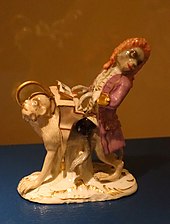Johann Christof Rombrich
Johann Christof Rombrich (born November 17, 1731 in Dresden , alternatively in Blankenburg ; † December 28, 1794 in Fürstenberg ) was a German porcelain modeller and embosser . As the successor to Simon Feilner , he was the most important modeller at the Fürstenberg porcelain factory in his day .

Johann Christof Rombrich is said to have been the son of an employee of the Dresden Silver Collection, nothing is known about his mother. Since a Johann Gottlob Rombrich had been working as a stone cutter in Blankenburg since 1749, where he made jewelry for the court in Wolfenbüttel , the place of birth was often confused in older literature. It is unclear whether and how the Rombrich brothers were related to Johann Gottlob Rombrich. From 1752 he worked for Johann Christof Verputzer (plasterer, bossier) in Meißen , where he was trained by Johann Joachim Kändler . Through the porcelain trade in Blankenburg, Johann Christof and his brother Johann Heinrich Rombrich, who was court factor in Blankenburg at the time , first came into contact with Fürstenberg porcelain. In 1757, Johann Christof began to manufacture molds for the Fürstenberg porcelain factory while still living in Blankenburg. As these evidently met with approval, Johann Georg von Langen Rombrich made the offer to go to the Fürstenberg manufactory as an inspector. He accepted this offer on the condition that his brother was allowed to accompany him to Fürstenberg as commissarius .

Rombrich arrived in Fürstenberg in February 1758 and initially worked as a second modeller, mainly for tableware. From 1762 he was inspector of the manufactory. The height of its activity began in the 1770s and lasted until death. Now he mainly made models for figures and after Simon Feilner's dismissal in 1768 he was the manufactory's most important modeller. At first he copied works from the Meissen porcelain factory , later he also created important works of his own. His work includes a pair of gallantry men about 15 centimeters high , a lidded box in the shape of a snipe (around 1760), a shepherd with a dog (1774/75), a woman with a lyre, a man with the magic lantern. From Meissen he copied groups that he learned in training, such as a monkey band or a group of dolls in disguise. In most cases the animal figures are difficult to assign to Feilner or Rombrich. His most important works included equestrian statues, cameo-like medallions from professors from the University of Helmstedt and ducal coats of arms. Several larger busts of members of the Braunschweig court and the princely family are considered to be among the best works of this genre. Since 1772 Rombrich no longer appeared among the employees of the manufactory, but due to his artistic importance even received double the wages of a former. Even when many of the employees were dismissed due to financial difficulties in 1774, Rombrich remained in his position on the orders of the ducal. Duke Karl I knew about the artistic importance of Rombrich for manufacture. Even before his arrival in Fürstenberg, he had the opportunity to meet and portray Duke Charles I in person in February 1758. The duke and his daughter, the hereditary princess and abbess of Gandersheim Abbey Augusta Friederika Luise, were godparents of the two children Rombrich had with his wife Johanna Maria, née Sommer (marriage 1765; † 1788). In 1790 he married Elisabeth Juliane Oelmann a second time.
literature
- Christian Scherer: The Fürstenberg porcelain ... With title picture and 179 images in the text . Berlin 1909, p. 34 ff., 92, 95 ff . ( archive.org - Rombrich is mentioned on other pages).
- Rombrich, Johann Christoph . In: Hans Vollmer (Hrsg.): General lexicon of fine artists from antiquity to the present . Founded by Ulrich Thieme and Felix Becker . tape 28 : Ramsden-Rosa . EA Seemann, Leipzig 1934, p. 560 .
- Hartmut Wegner: Rombrich, Johann Christoph. In: Horst-Rüdiger Jarck , Dieter Lent et al. (Ed.): Braunschweigisches Biographisches Lexikon - 8th to 18th century . Appelhans Verlag, Braunschweig 2006, ISBN 3-937664-46-7 , p. 594-595 .
- Beatrix von Wolff Metternich, Manfred Meinz : The porcelain manufactory Fürstenberg. A cultural history in the mirror of Fürstenberg porcelain. Volume 1 (= Braunschweigisches Kunsthandwerk (BKH), Volume 1.1), Prestel, Munich-Berlin-London-New York, ISBN 3-7913-2921-9 , especially pp. 104-106.
Web links
Individual evidence
| personal data | |
|---|---|
| SURNAME | Rombrich, Johann Christof |
| BRIEF DESCRIPTION | German porcelain modeller and embosser |
| DATE OF BIRTH | November 17, 1731 |
| PLACE OF BIRTH | Dresden or Blankenburg |
| DATE OF DEATH | December 28, 1794 |
| Place of death | Furstenberg |